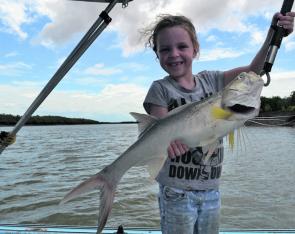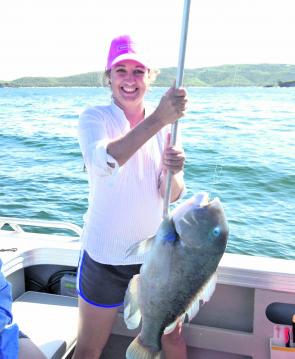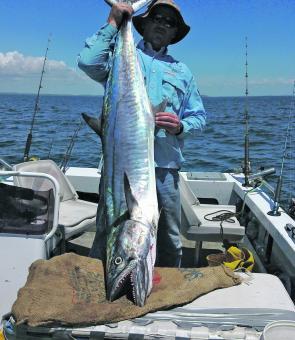The temperature has finally started to drop triggering a change and switching the winter fish on.
Bream are congregating in the creek mouths ready to spawn and are feeding pretty aggressively at present. Corio and Coorooman seem to be the pick until The Fitzroy slows after the big rains last month out west. The Causeway is another prime spot with the better captures just on dark or very early in the morning.
Queenfish are providing lots of action around the islands and Corio Heads. We use either lures or live baits depending on the tides and particular spot. Corio Heads is the perfect popper spot because you can get a long drift past the rocks where you can get a number of casts right into the white water and a fast retrieve back to the boat.
Plastics are another top method at Keppel, so you can cover a lot of territory until you find where they are feeding. The availability of hardiheads and herrings gives an option to those who wish to pick a likely spot and wait for the fish to arrive, and they will.
King salmon have had a great year so far and relishing the Fitzroy’s flood conditions as only they and barras can do. Some giant kings up to 20kg have been reported down around Port Alma, Balaclava and McKenzie islands. These big guys have been taking large live river prawns and poddy mullet readily.
Seeing them in action on a recent run down the river left me feeling well under gunned on my regular barra gear. Coorooman Creek and Waterpark are other places where fine kings are an option.
Mud crabs are still on the menu and like the past few years they haven’t begun to slow down as yet. There are stacks of prawns in the areas creeks although they are small right now, in current conditions they will be good bait size and eating size in coming weeks.
The strange seasons of the last couple of years has left a legacy of a serious amount of barramundi in the local systems. As yet they haven’t slowed down despite the cooler weather and it is still easy to catch them all over the area.
The pick location for quality barra has to be the mouth of Moores Creek where big barramundi are holding and smashing all the critters bought down with the big flow in the river. Until the fresh flow stops they will be there gorging themselves and taking anything that looks alive.
The locals continue to use spotted and silver perch caught in the local creeks and lagoons around Rockhampton. Coorooman Creek and The Causeway Lake have also had some big barra, but Corio seems to be home of the little fellas at the moment.
Lots of big whiting are appearing all along the coast at present with some horse sized specimens around the islands of the Keppels. You can get beachworms around the Keppels particularly on the eastern or southern beaches. We usually take a couple of frozen packs with us just in case we miss the low tide.
Most of the island beaches hold whiting much of the time. The smaller fish run the beaches around Yeppoon while the bigger fish range north to Five Rocks and back along the southern beaches heading into The Fitzroy River delta. Corio Bay, Coorooman Creek, Ross Creek and The Causeway are popular spots.
Long Beach and Rundles are favoured by the Keppel Sands locals when hunting whiting for a couple of reasons and the main one is the proximity, closely followed by the lack of people fishing there.
The preferred baits of yabbies and beachworms can be caught at various locations around Keppel Sands and Joskaleigh. These beaches have vehicle access and are a great spot to take the family away from the crowds in other areas. The whiting move along the beach with the tides hanging in the gutters.
Quite often you will see big salmon and barramundi smashing whiting in shallow water especially either end of the beach especially near the rocky mangrove patches. We always put out a decent sized live whiting on a surf rod while catching whiting.
The only drawback is the soft patches around the creek travelling down to Rundles. This can be a trap for the inexperienced and the big tides make it very easy to lose a vehicle with no chance of getting out by yourself. Stay around Long Beach unless you are with a local who can show you how to get through.
Five Rocks and Nine Mile are the other spots where large whiting are going off. At the northern end of our local area, these are only accessible by 4WD or boat.
The trip in from Byfield through the national park is worth the effort alone and when you get to the top of the hills overlooking the beaches the outlook is spectacular. Soft sand makes it experienced off road only and the tides are the other thing to be aware of. You can only travel the beaches when the tide is down a bit right down to low.
These beaches have headlands either end with surf and sand banks in the middle, making plenty of gutters to share among the regulars who head up every weekend without ever being crowded.
The beachworms here are among the biggest you will find anywhere in Queensland with some well over 6ft. Take some heavier gear with you because the location attracts everything from blue salmon, trevally, queenfish, mackerel to cobia all of which can be seen cruising just outside the shore break at times.
Live whiting or whiting fillets will catch nearly every predatory fish in the local area from barramundi and salmon to all the reefies including trout and red emperor.
Those huge Spanish mackerel in the areas waters lately are still here along with plenty of school sized Spanish for anyone who targets them. The bigger fish have been just north up at Cape Manifold and the southern end of the bay at Cape Capricorn and Rundle Island. The rest of the local spots including Barren, Outer, Man and Wife, Conical, Flat, Perforated, Liza Jane and Humpy have been the places to get the more popular 6-10kg models without fear of ciguatera.
The last couple of bigger fish I have had several small feeds on over a few days before giving any to the oldies or kids to make sure they were safe after two reports of ciguatera early in the year. We don’t often get it here but it pays to be on the safe side with any very large Spanish mackerel or coral trout.
Reefies are still on the chew in many of the areas rubble patches from not far behind the Keppels right out to the Shoals and the deeper red fern country. Red emperor, largemouth nannygai, grassy sweetlip, red throat emperor, bluetooth, cod and coral trout are making up the large part of the captures with the better fish now moving into the slightly deeper spots.
Wahoo and cobia numbers have increased lately as have mahi mahi particularly out at the shoals. Grunter and black jew are also picking up again around the new and full moons especially at the closer spots like Findlays, The Rama and The Pinnacles.
Reads: 2451
Abby from with a great local salmon.

Kelly Vogel with a blue tuskfish.

Thommo with a horse Spanish caught in quite close.




